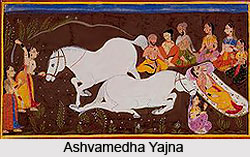 Ashvamedha is also known as the horse sacrifice. During the Vedic and the Epic age it was the ambition of every king to perform at least one such custom in the course of his reign. It is believed that this sacrifice is done to fulfil two purposes. It would ensure a heaven for the King, prosperity for his kingdom and people as well as establish his own importance thereby exerting a greater influence over the Kings ruling nearby his kingdom. This ceremony was revived in the second century and evidently continued till the 10th century.
Ashvamedha is also known as the horse sacrifice. During the Vedic and the Epic age it was the ambition of every king to perform at least one such custom in the course of his reign. It is believed that this sacrifice is done to fulfil two purposes. It would ensure a heaven for the King, prosperity for his kingdom and people as well as establish his own importance thereby exerting a greater influence over the Kings ruling nearby his kingdom. This ceremony was revived in the second century and evidently continued till the 10th century.
Performance of Ashvamedha
This sacrifice basically involved a programme of activities that lasted for a year. In the spring time a horse was sanctified and released to wander with him. He also travelled one hundred other horses as well as a band of four hundred chosen young warriors, whose duty was to follow the horse wherever he led them. If the horse wandered beyond the boundary of the King`s kingdom who released him, the local rulers were called to pay tribute. If they refused, the warriors will fight a battle. Failure of this sacrifice is unheard of. However no sensible king would carry out such an expensive ceremony without a certainty that it would be as success. The horse would be returned to the king at the end of the year. It would be sacrificed by strangulation or suffocation along with a large number of other animals. The Asvamedha involved a series of secondary activities in which the entire population might take part passively. These included the recitation of stirring ballads that describes the exploits of the king`s ancestors, as well as dance and song.
Features of Ashwamedha
Ashwamedha ceremony is also known for the sexual character of one of the final ceremonies. The King`s queen lay down beside the body of the sacrificed horse and simulates copulation with him. Asvamedha had some of its roots in very ancient fertility ceremonies. The purpose was to ensure land productivity represented by the queen. However this ritual laid stress on political power. While the wandering of the horse if any king tried to block his passage as well as had been defeated in the battle, he would not be dethroned by the conqueror. The defeated king would appear at the final ceremony and accept the supremacy of the victor. Asvamedha never encouraged the building of centralized empires. It visualized a loose federation of kingdoms under a single leadership, all independent as far as their internal affairs are concerned.
Historical Ashwamedha Performances
Performances of the Ashvamedha have been mentioned in the epics of Ramayana and Mahabharata. In the Mahabharata it is performed by Yudhisthir. In the Ramayana, it is performed by King Dasaratha. It was also performed by Lord Rama too. In Mahabharata the sacrifice is also performed by King Vasu Uparichara. It is believed that Pushyamitra Sunga has performed this rite after defeating the Mauryans in 185 BC. It is historically evident that Ashvamedha was performed during the reign of Samudragupta. King of Kannauj performed the sacrifice and was unsuccessful in it in the 12th century. The last known instance of performing this rite was in 1716 CE, by Jai Singh II of Amber, Jaipur.



















